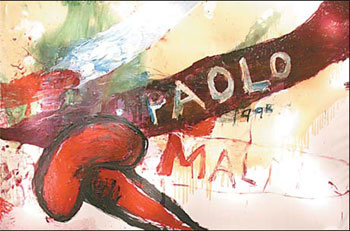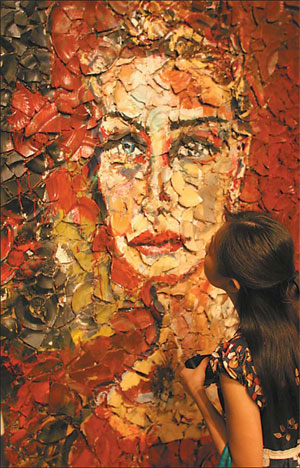On a plate
Julian Schnabel's plate paintings reveal not only a dialogue with the artist, but also a chapter of art history. The artist paints large-scale portraits of women on surfaces covered by broken plates and smashed crockery.
|
The showing of Schnabel's private collection at the Beijing World Art Museum marks the artist's first solo show in Asia.Photos by Jiang Dong |
The paintings remind many of Pablo Picasso and Jackson Pollock, with deconstruction and reconstruction of seemingly unrelated pieces in a beautiful way. Influences of Impressionism and neo-Impressionism are evident, but this artist goes further to twist interpretations of different styles to make something new.
The 30-piece exhibition of Schnabel's private collection is on show at the Beijing World Art Museum through October 14, in an exhibition, which marks the artist's first solo show in Asia.
Today, Schnabel is considered one of the most important figures in the art world, but in the early 1980s, he was just one of many struggling young artists, supporting himself by cooking and driving a taxi.
After studying in the University of Houston, he sent an application to the independent study program at the Whitney Museum of American Art in New York. He included slides of his work sandwiched between two pieces of bread. He was soon accepted to the course. He quickly rose to fame by using enormous canvases filled with vibrant colors. In 1979, he earned immediate acclaim after launching his first exhibition at Mary Boone Gallery in New York.
Most of the exhibits at the Beijing show are big works, about 2 meters long and wide.
Schnabel uses a big canvas to create a space and lure the viewer into his vibrant world.
"When you look at big paintings, because of their size, you feel like you are in the picture, it's like a place, an experience," says Mary Dinaburg, Schnabel's spokeswoman.
"The other reason is that he thinks the world we are living in is made up of many different parts, so he likes to make his painting from all different parts, elements, materials, a figure, or a photograph.
"When you have a large canvas, you can put all the elements together. It's like reading his world, which makes you want to enter it."
At the Beijing show, various elements include oil, wax, a worn-out army tent on which Schnabel paints an abstract ancient Chinese woman, and the brush marks of resin that cover the weird smile of Marlon Brando.
Thanks to his charisma, both in his works and personality - he used to wear a dilettante uniform of pajamas, slippers and a robe while he painted in his studio - Schnabel quickly became an overnight superstar in the 1980s, although his works often raise divided responses. Controversy arose when he launched the famous plate paintings from the late 1970s.
|
A Beijing visitor in front of a portrait of woman by Julian Schnabel. |
The large-scale works, set on broken ceramic plates, offended some by apparently flouting the traditional conception of high art. Others appreciated the innovation, because no one else had ever made such a comment before and articulated the message so beautifully. Two of the plate paintings series are shown this time in Beijing.
Amid the controversy, Schnabel's works toured the world's most important galleries. Aged in his late 20s, he was the youngest artist to hold a retrospective show in Tate Gallery.
Some critics say his immense success is attributed to the booming economy in the 1980s, more than just his art achievements. Art buyers loved him, and his exhibitions were nearly always sold out.
His portraits are another must see at the Beijing show. The large-scale paintings powerfully connect with the viewer.
The visual impact is immediate. The characters protrude from colorful backgrounds with solemn facial expressions. The subject appears to be stepping out of the frame, ready for a conversation.
Dinaburg admires Schnabel because unlike those artists who have enjoyed early success, the 55-year-old master was never trapped under the pressure of "being a young artistic star" and was confident enough to constantly innovate.
In 1996, Schnabel turned to filmmaking. He wrote and directed his first film, Basquiat, a biopic on the painter Jean-Michel Basquiat. It was nominated for the Golden Lion at the 1996 Venice Film Festival. It featured an all-star cast - Benicio Del Toro, Dennis Hopper, Gary Oldman, David Bowie, Christopher Walken and Willem Defoe. Oscar winning actor Del Toro loved Schnabel's script so much he offered to act for nothing.
The artist's second film, Before Night Falls, followed the widespread critical acclaim of his debut and its lead actor, Javier Bardem, was nominated for an Oscar.

What followed was another biopic of Cuban poet Reinaldo Arenas.
Schnabel only makes films of those artists whom he respects and thinks are creative, or at least living in a creative way, says Dinaburg.
"He does not make a movie for Hollywood," she says. "The stories are not about fame, but the art world. How the artists live, work, and interact with other artists."
His latest opus, The Diving Bell and Butterfly, won a coveted director's prize at Cannes.
"I have the same conviction and immersion in making the film as when I'm painting," he was quoted as saying about his success in both fields.
(China Daily 09/19/2007 page18)
















